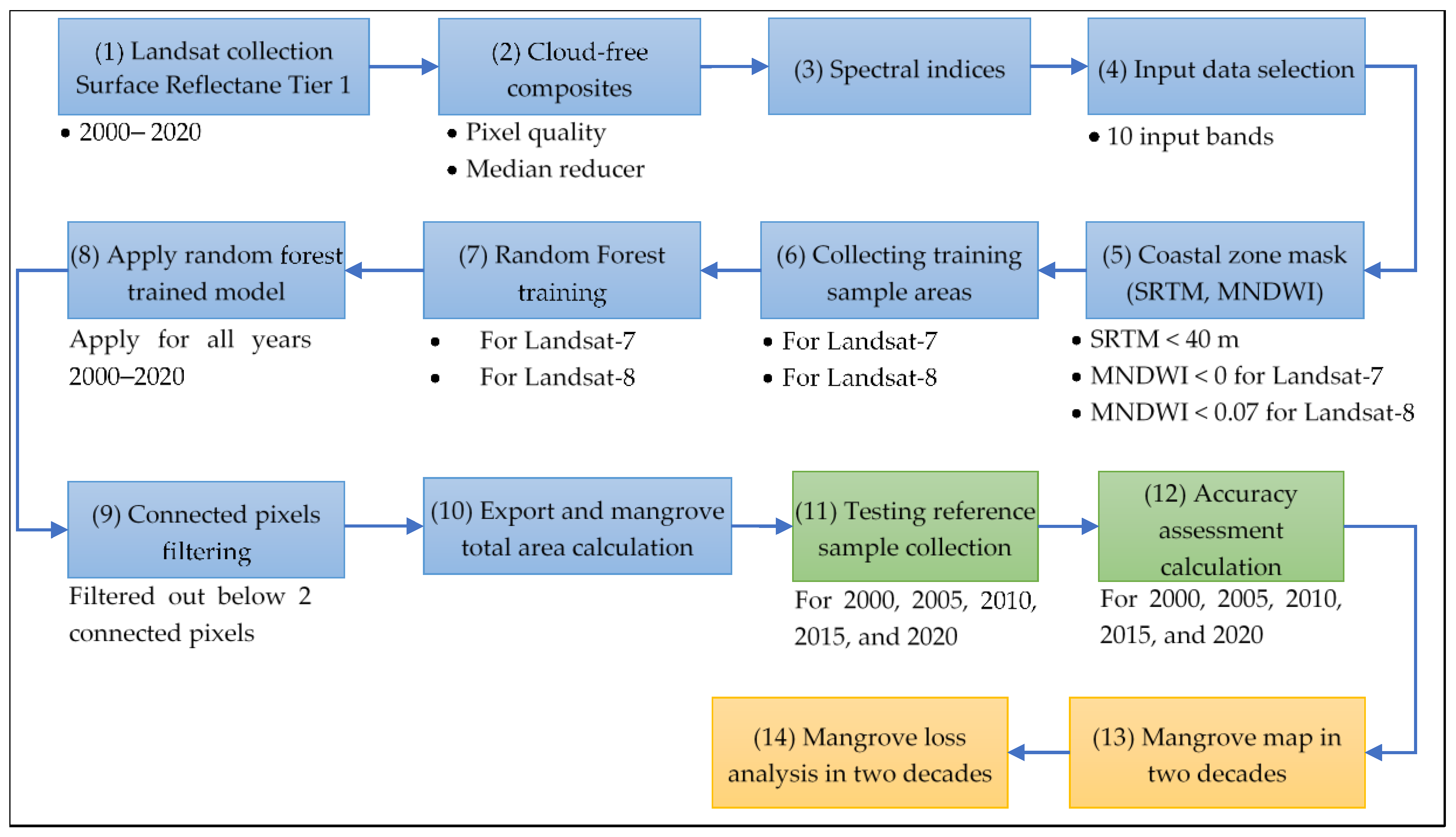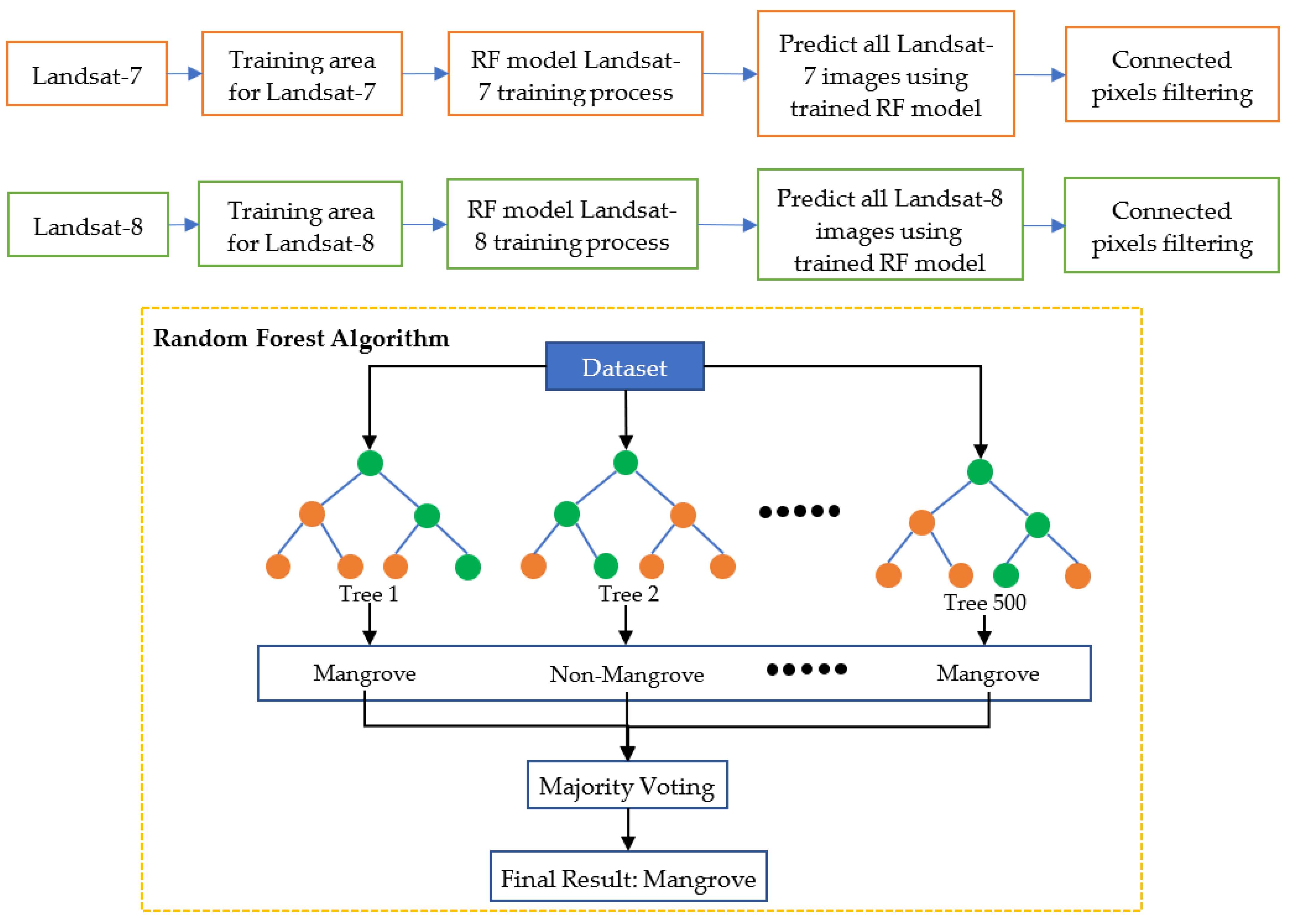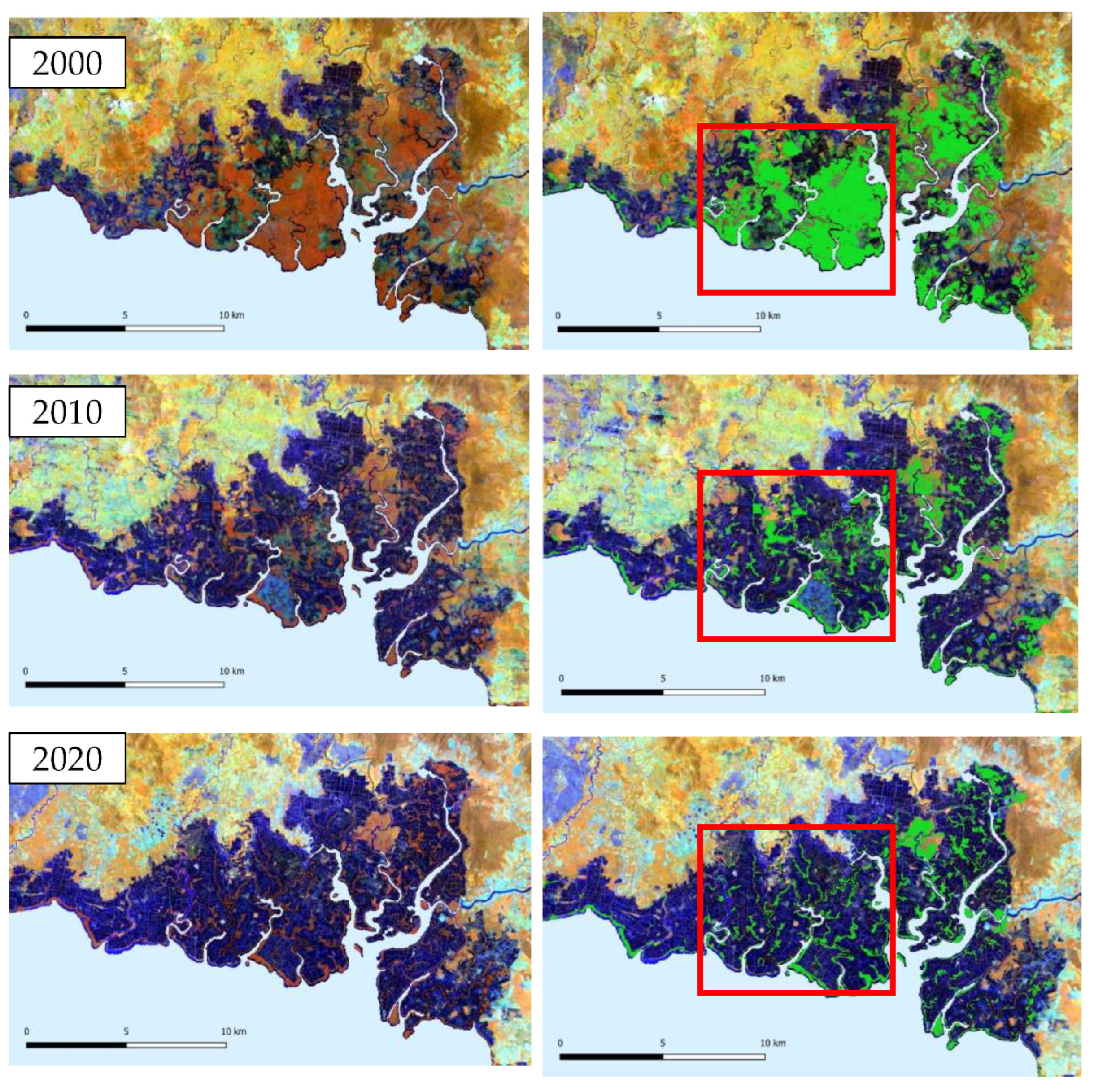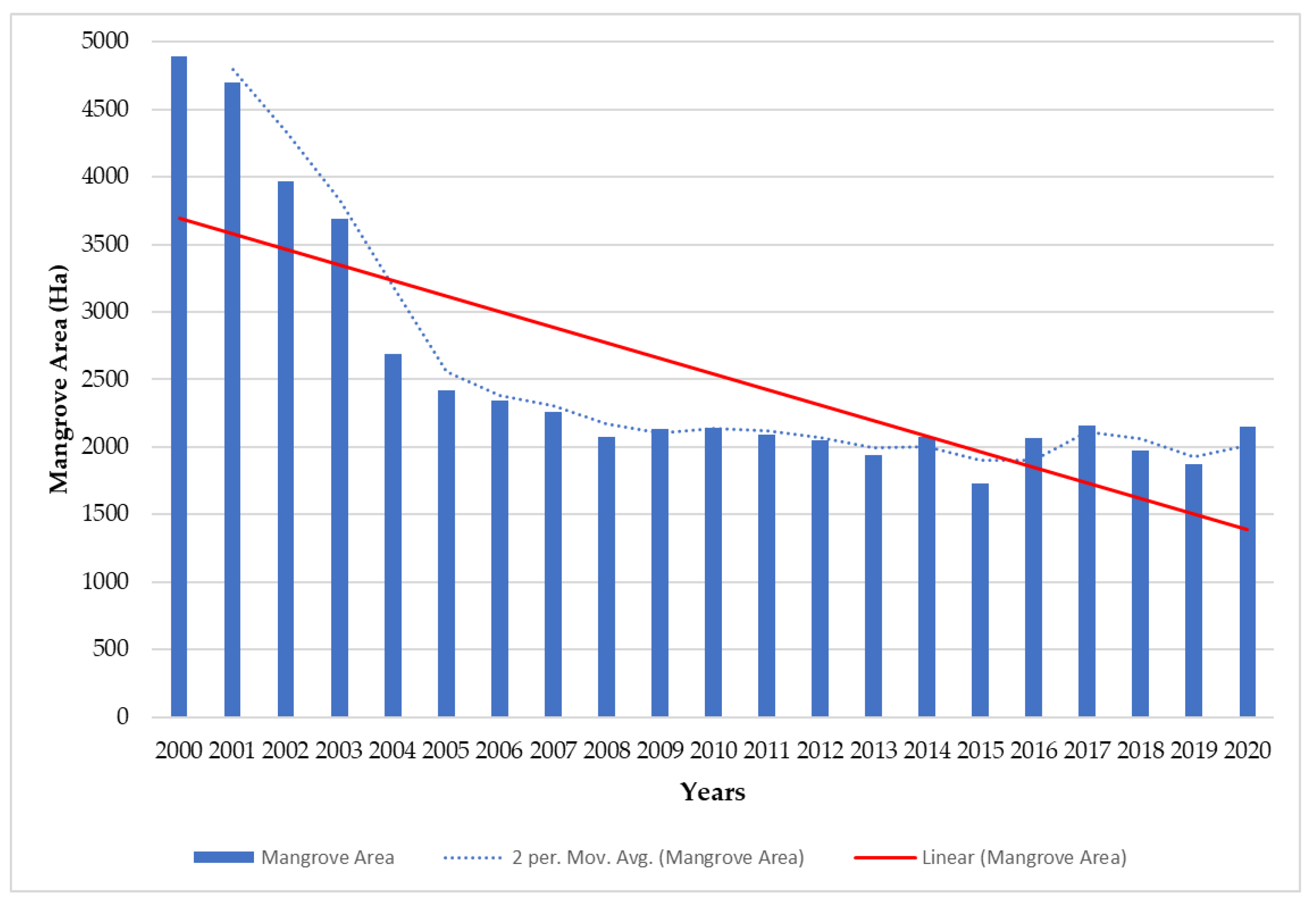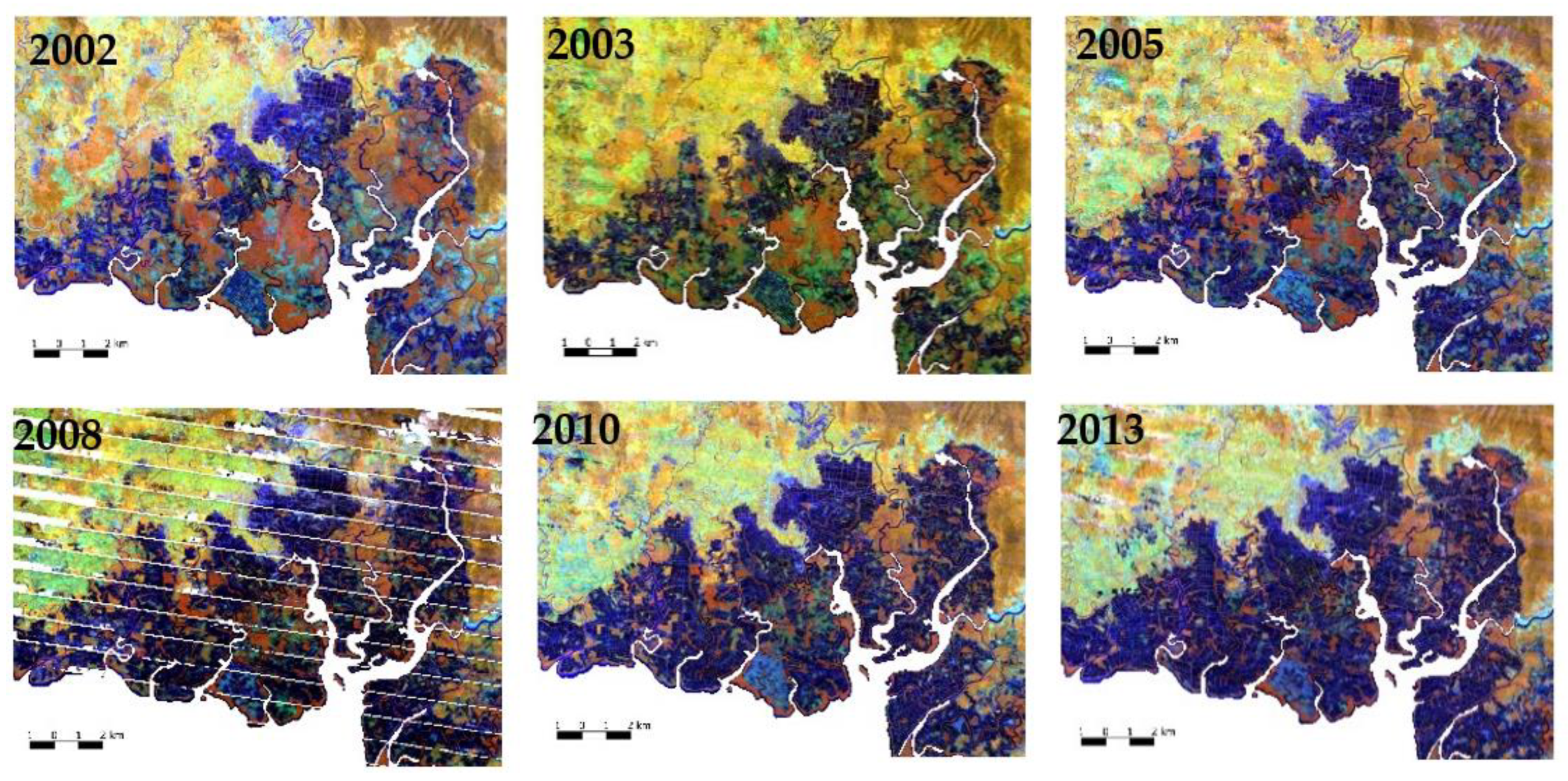1. Introduction
Mangroves are vegetation located in tidal zones in the tropical and sub-tropical areas and have various roles in protecting coastal ecosystems [
1]. Mangroves have a major impact on climate change mitigation strategies based on the reducing emissions from deforestation and forest degradation (REDD+) scheme [
2]. This is because the mangroves have the ability to absorb carbon, thereby reducing the concentration of greenhouse gases in the atmosphere and preventing the impact of climate change [
3]. Mangroves also have ability as the coastal vegetation that can protect the coastline area [
4], commercial vegetation [
5], and biodiversity conservation [
6]. In addition, another important role of mangrove forests is to reduce the CO
2 emissions in the atmosphere according to their ability to store high carbon stocks [
7]. The majority of mangrove exosystem carbon storage is located in the soil [
8]. Sanderman et al. [
9] revealed between 2000 to 2015 up to 122 million tons of mangrove soil carbon were released associated with the mangrove forest loss.
Mangrove quantitative analysis monitoring needs to be carried out effectively to support policy-making related to mangrove conservation [
3]. Monitoring used time-series data to know the dynamic changes in an area [
10]. Based on the previous research, the global distribution of mangroves has lost about 35% from 1980 to 2000 [
11], and the annual mangrove loss rate from 2000 to 2012 is 0.26–0.66% [
12]. The greatest diversity of mangroves is located in Southeast Asia [
13]. Whereas in Asia in the 1980s and 1990s, almost a third of mangrove forests were lost [
11]. In Southeast Asia, the main factor that caused mangrove deforestation is the aquaculture industry [
14]. The average rate of mangrove loss between 2000 and 2012 in Southeast Asia is 0.18% per year [
15].
The most effective and efficient method of time, cost, and energy in monitoring the condition of the mangrove ecosystem is by utilizing remote sensing data [
16]. Remote sensing satellite data provided time-series data that can be used for mangrove monitoring. Recently, the development of computer technology provides convenience in automatic land cover mapping using remote sensing imagery. The integration of machine learning algorithms and satellite imagery has been widely used for mangrove mapping. Kamal et al. [
17] used a support vector machine (SVM) for mangrove mapping using Landsat data, Diniz et al. [
18] used random forest (RF) for mangrove mapping using Landsat data for three decades of mangrove monitoring in Brazil, while Mondal et al. [
19] compared decision tree (DT) and RF for mangrove mapping using Sentinel-2 data. Those previous research revealed convincing results of using machine learning and remote sensing imagery for mangrove mapping.
Time series monitoring using remote sensing satellite data requires large computing and storage capacities [
18]. The advent of cloud computing platforms such as Google Earth Engine (GEE) provides analysis-ready data (ARD) of satellite imagery and machine learning algorithm that are specially designed for land cover classification in cloud computing servers [
20]. The GEE cloud computing platform allows us to filter and sort satellite imagery and make it easier for us to obtain time-series data. The spectral indices processing also can be finished in the GEE cloud computing. With several advantages of the GEE platform, mangrove monitoring using satellite imagery can be solved with the GEE platform.
The aim of this paper is to produce two decades of mangrove loss monitoring in East Luwu, Indonesia between 2000 to 2020 using satellite imagery and an RF algorithm. The time-series mangrove cover area in this paper has been produced by using the GEE platform. To the best of our knowledge, our work is the first to use RF algorithm and satellite imagery to produce and analyze two decades (2000 to 2020) mangrove loss monitoring in East Luwu, Indonesia.
3. Results
This section presents the RF classification results in the years 2000, 2010 and 2015 (
Section 3.1). The confusion matrices for the years 2000, 2005, 2010, 2015 and 2020 are also shown in
Section 3.1. Based on the evaluation assessment results, the produced maps show good OA scores larger than 0.95. The two decades mangrove loss analysis is explained in
Section 3.2.
3.1. Classification Results
After the RF training process for Landsat-7 and Landsat-8, the trained models were used to predict non-mangrove and mangrove areas in the whole study area for the years 2000 to 2020. The trained Landsat-7 RF model was used to predict non-mangrove and mangrove areas from the years 2000 to 2013, while the trained Landsat-8 RF model was used for the years 2014 to 2020. The visualization result of the mangrove area and Landsat composite (NIR, SWIR 1, Red) every 10 years (2000, 2010 and 2020) are shown in
Figure 5. Visually, mangrove objects in Landsat composite (NIR, SWIR 1, Red) will look reddish-orange if we compare them with the other vegetation type.
Based on the visualization classification result, in 2000 almost all of the tidal zone is covered by the mangrove forest and just some areas are already covered by the aquaculture pond. 10 years later in 2010, there is a lot of mangrove forest deforestation, especially in the red box, all of the mangrove forests become non-mangrove (aquaculture pond). While based on the classification visualization result in 2020, the distribution of mangroves is similar to the year 2010, only slight changes occurred in some areas. The comparison analysis based on the visualization results from 2000, 2010 and 2020 shows the highest rate of mangrove deforestation happened between the years 2000 to 2010, while only slight changes happened ten years later (2010 to 2020). There were a lot of mangroves in 2000 and then deforested in 2010 according to the classification result.
The second result of this study is the evaluation assessment to know the quality of classified mangrove and non-mangrove areas. The independent testing samples were collected to perform the evaluation assessment by calculating the OA score, UA score, and PA score. A total of 2500 testing samples were used here from the years 2000, 2005, 2010, 2015 and 2020 to calculate the confusion matrix as shown in
Figure 6. In general, the classified maps achieved OA score of more than 0.95 in all 5 years results. The highest OA score is from the year 2000 (0.982), while the lowest OA score is from the year 2005 (0.954). The reason why the 2000 classified result has the highest OA score is the trained model using the training data from the year 2000.
Based on all confusion matrices the UA score and PA score of the non-mangrove class is higher than the mangrove class. These results indicate the mangrove class is more difficult to identify than the non-mangrove class. The lowest UA score for the mangrove class is in the year 2005 (0.908), while the highest UA score for the mangrove class is in the year 2000 (0.982). In general, the classified maps from the trained RF model produced acceptable non-mangrove and mangrove maps based on the evaluation assessments.
3.2. Mangroves Loss Monitoring
The two decades (2000 to 2020) mangrove loss monitoring in this study is based on produced mangrove maps using an RF algorithm. The results of observations were carried out by looking at changes in the mangrove areas every year. The spatial distribution of the mangrove area shows a change in the location of the mangrove area from 2000 to 2020. Based on the produced mangrove maps every year, the total area of mangroves in two decades is shown in
Figure 7. The largest total mangrove area in East Luwu was found in the year 2000 with a total mangrove area of 4895.26 Ha. While the lowest total mangrove area was found in the year 2015 with a total mangrove area of 1730.24 Ha. Based on the linear trendline (red line), the total area of mangroves in East Luwu from 2000 to 2020 has a decreased trend. The most significant decrease occurred in the years 2000–2005. After 2005, there was a narrowing of the fluctuating mangrove areas. The moving average line shows the high deforested mangrove area from 2000 to 2005, then after 2005 become more stable. In 2020 we can find a slight increase in mangrove area compared with the previous year. Based on the linear trendline and moving average line, the status and condition of mangrove forest in East Luwu from 2000 to 2020 tends to decrease.
The result of the intact and loss mangrove area in 2000 to 2020 is shown in
Figure 8. The highest mangrove deforestation area can be seen in the orange zoom box. Based on observations of the spatial distribution of the front area is dominated by intact mangrove areas and changes in the mangrove area in 2000 and 2020 are behind it. The shrinkage of mangrove area based on the distribution in 2000 was influenced by changes in land use in the East Luwu area to become a pond area. Intact mangroves in the foreground are used to protect coastlines and aquaculture areas. The addition of mangrove areas in 2020 is outside the mangrove area in 2000 and has a narrow distribution. Based on the results of the distribution on the map, it is known that the narrowing of the mangrove area is behind intact mangroves and is influenced by changes in land use into pond areas.
4. Discussion
The study area of this research is located in the East Luwu, Indonesia with high rate of mangrove deforestation around the study area [
12]. Time-series Landsat-7 and Landsat-8 images were used here to produce mangrove map in two decades (2000 to 2020). While RF algorithm was used here as the classifier function in the GEE platform. The trained RF model from the year 2000 (Landsat-7) was used to produce mangrove maps from 2000 to 2013, while the trained RF model from the year 2014 (Landsat-8) was used to produce mangrove maps from 2014 to 2020. The OA score, UA score, and PA score from the evaluation assessment using the independent testing dataset are shown in
Table 6. The average OA score from the produced maps (2000, 2005, 2010, 2015 and 2020) is 0.966, while the UA score for the mangrove class is lower than the non-mangrove class but still acceptable. The produced mangrove map using RF trained model achieved good results in terms of accuracy matrices. Based on these results, we assumed all the produced mangrove maps every year can be used for mangrove monitoring analysis.
We calculated the mangrove loss rate percentage per year for every 5 years for further analysis (
Table 7). The calculation of mangrove loss rate in this study is based on previous research with following equations [
32]:
where A
1 and A
2 are the forest cover at time t
1 and t
1, respectively. The unit for the annual rate is per year or percentage per year.The first-half first decade (2000 to 2005) has the greatest annual mangrove loss rate among others. The mangrove loss rate in the first-half first decade is −14.11% with the total loss of mangrove area of 2477.39 Ha. This result revealed massive mangrove deforestation in East Luwu from 2000 to 2005. The main factor is the conversion from mangrove areas to aquaculture ponds which happened a lot from 2000 to 2005.
The second-half first decade (2006 to 2010), revealed mangrove loss rate of −2.24% per year with a total loss of mangrove area of 201.51 Ha. The mangrove loss rate in the second-half first decade is not really high as in the first-half decade. While the mangrove loss rate in the first-half second decade (2011 to 2015) increased from the second-half first decade. The mangrove loss rate from the first-half second decade is −4.75% with the total mangrove deforestation area of 362.40 ha, which differs from the previous 5 years by 160.88 Ha. From 2006 to 2015 we found fewer mangrove areas were deforested compared with the first-half first decade (2000 to 2005). The trendline analysis in
Figure 7 also shows the narrowing of the fluctuating mangrove areas after 2005. Based on our visual analysis, the decreasing mangrove areas from 2006 to 2015 are still mainly influenced by the aquaculture ponds. After 2005, the loss of mangrove areas is not very high, it is related with the regional government regulation (Peraturan Daerah Luwu Timur No. 2 Year 2005: Rencana Pembangunan Jangka Panjang (RPJP) 2005–2025). This regulation mentioned about environmental issues related to aquaculture ponds and land clearing. In addition to that factor, the procurement of new aquaculture pond has also decreased after 2005 based on visual analysis.
While in the last second decade (2016 to 2020), we found a positive loss rate (+1.04%) percentage which means there is an increase in the total mangrove area in the study area. The total increased mangrove areas from 2016 to 2020 is 87.96 Ha, which does not increase too much. We used Landsat-8 (2016 and 2020) and Sentinel-2 data (2020) as a finer spatial resolution for the visual observations. Based on our observations, the slight increase of total mangrove area in the last second decade was mainly caused by the natural restoration of mangrove areas that happened in mangrove areas directly adjacent to water areas (ocean and river). We also found small abandonment aquaculture ponds in 2016 turned back into mangrove areas in 2020. In fact, there is still conversion of mangrove forests into aquaculture ponds from 2016 to 2020.
The limitation from the produced mangrove maps in this study is divided into two types. The first type is cloud cover effects in the study area, even though we already used the cloud masking function in the GEE platform, some area still has cloud cover effects. The second type is about scanline error in the Landsat-7 imagery. The scanline errors happened in the Landsat-7 image starting from 2003. We used a median filter from January to December for each year to minimize the scanline error in the Landsat-7 images. Almost all Landsat-7 data from 2003 to 2013 have small scanline errors so it doesn’t affect the classification results much, just the year 2008 has very huge scanline errors (
Figure 9). Therefore, the produced mangrove maps from 2003 to 2013 are still acceptable since they had a small scanline error and achieved a good OA score from the evaluation assessment. We only used Landsat-7 images for the year 2000 to 2013 even though they have scanline errors because we cannot find the Landsat-5 data in our study area after the year 2003. To the best of our knowledge, much Landsat-5 data in the specific region and year is still decentralized and not available in the global database. The scanline errors and cloud cover effects affected the produced mangrove cover maps in the whole study area. Future research needs to pay more attention to the scanline errors of Landsat-7 or uses other satellite imagery.

